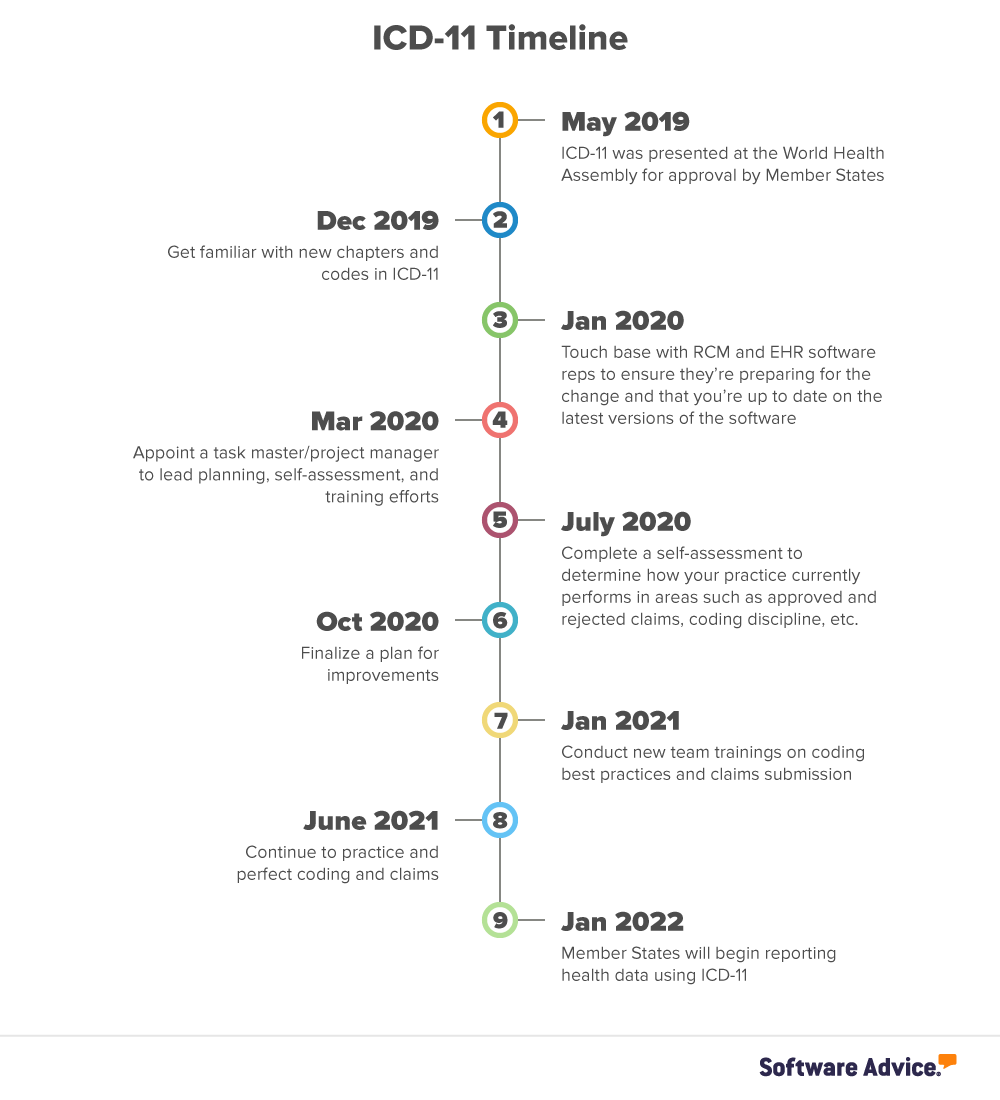The ICD-11 Transition Timeline
After the tumultuous transition to the 10th International Classification of Diseases, simply saying the phrase “ICD-11″ is liable to strike fear in the hearts of medical providers across the country.
But the inevitable truth is that ICD-11 is looming large on the healthcare horizon, and physicians who are unprepared for this transition will see an uptick in rejected claims and a drop in reimbursements—so preparation is key.
In this article, we’ll go over a detailed timeline to help you create deadlines for yourself and pace out your own transition from ICD-10 to ICD-11, all while avoiding complicated diagnostic issues that could impact your revenue cycle.
Here’s what we’ll cover:
The ICD-11 transition timeline
Prioritize software maintenance and team training
What is ICD-11?
ICD-11 is the newest iteration of the International Classification of Diseases scheduled to take effect in January 2022.
As you probably already know, ICD-10 was introduced way back in 1992, and it took the U.S. 23 years to completely transition to it. So after only having completed that arduous process in 2015, why are we doing it all over again with ICD-11?
Here’s the big answer: ICD-10 was current back in 1992 when it was first introduced, but in the two decades it took the U.S. to adopt it, ICD-10 simply went out of date.
Expect the following changes in the shiny new ICD-11:
Changes have been made to make the coding system more modern, more comprehensive, and most importantly, more easily integrated with electronic health records. The newest version will be fully electronic, offering resources such as the online Coding Tool, Reference Guide, and Browser.
Another big change is the introduction of code clustering, a new process that will let practices combine multiple codes to describe a diagnosis more specifically.
The last major change has a few existing diagnoses changing location, and new diagnoses have been added—including burnout and gaming disorder.
It really is going to make your life easier, so the sooner you adopt it the sooner you can begin seeing those results.
The ICD-11 transition timeline
For the purposes of this timeline, we decided to begin with the ICD-11’s presentation at the World Health Assembly, which took place in May. Before it was presented, the proposed revision was made available to providers to collect feedback and make adjustments. The version that was presented at the assembly was, for all intents and purposes, the final draft.

At the end of our timeline is, naturally, the deadline. At this point, providers in Member States will be expected to begin using the ICD-11 to code and report health data, which means you have two and a half years to pace out the rest of the tasks on this timeline. Not a moment to lose.
Prioritize software maintenance and team training
When thinking about the transition to ICD-11, you have essentially two very big boxes you’ll need to check:
Is your software ready for ICD-11?
Is your team ready for ICD-11?
Preparing your software: Reach out to software providers for ICD-11 prep
Are you currently using a revenue cycle management system, an electronic health records system, or a medical billing system?
If the answer is yes, you should start thinking about contacting your software providers to discuss their preparations for ICD-11 and ensure you have (or will receive) an updated version of their software if need be.
Hopefully, your software provider offers good customer support that will be equipped to have these conversations with you. Reach out to your software reps and start that dialogue after you’ve had a chance to familiarize yourself with the new chapters and coding system in ICD-11, but before you begin training your team on new best practices.
Doing so at this point in the timeline lets you have an informed discussion with your software provider, which in turn will help you create an effective and accurate training guide for the new ICD-11 coding processes.
Preparing your team: Designate a task manager to handle team training
Preparing your team for the adoption of ICD-11 is likely going to be the bigger task in this process, so it’s a great idea to establish a point person (or team, if you have the resources) to manage the transition.
Once selected, your task manager will face a three-stage project:
Stage 1: Self-assessment
The first step to making any major change like this is to figure out where your team is currently and how far it needs to go. To do that, think about things like:
How efficient current claims and coding processes are
What kinds of training and reference materials are currently available to your staff
Current claims acceptance and rejection rates
Stage 2: Implementation planning
Figuring out how your team currently performs in terms of coding discipline and what kind of success rate you’re seeing for submitted claims will tell you how much work you need to do to prepare for the new coding system.
Stage 3: Practice and perfect new processes
From there, your task manager can create a plan for training your team, conduct training sessions, oversee the transition and be a resource for your team as they adjust. The goal in this time will be to get as good as you can at using detailed, specific ICD-10 codes. Establishing those habits will serve your team well when ICD-11 is implemented.
If you found this ICD-11 transition timeline helpful, feel free to use the social buttons to share this article on Facebook, LinkedIn or Twitter. You can also find me on Twitter @GDMLisa if you have questions or comments.